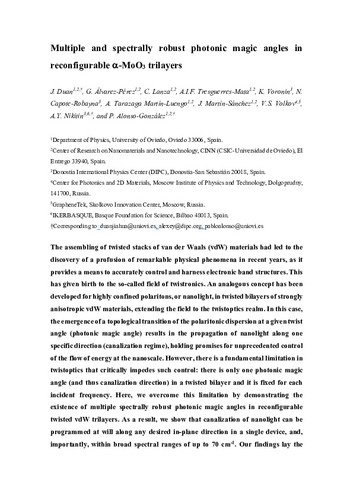Multiple and spectrally robust photonic magic angles in reconfigurable α-moo3 trilayers
Fecha de publicación:
Versión del editor:
Citación:
Descripción física:
Resumen:
The assembling of twisted stacks of van der Waals (vdW) materials had led to the discovery of a profusion of remarkable physical phenomena in recent years, as it provides a means to accurately control and harness electronic band structures. This has given birth to the so-called field of twistronics. An analogous concept has been developed for highly confined polaritons, or nanolight, in twisted bilayers of strongly anisotropic vdW materials, extending the field to the twistoptics realm. In this case, the emergence of a topological transition of the polaritonic dispersion at a given twist angle (photonic magic angle) results in the propagation of nanolight along one specific direction (canalization regime), holding promises for unprecedented control of the flow of energy at the nanoscale. However, there is a fundamental limitation in twistoptics that critically impedes such control: there is only one photonic magic angle (and thus canalization direction) in a twisted bilayer and it is fixed for each incident frequency. Here, we overcome this limitation by demonstrating the existence of multiple spectrally robust photonic magic angles in reconfigurable twisted vdW trilayers. As a result, we show that canalization of nanolight can be programmed at will along any desired in-plane direction in a single device, and, importantly, within broad spectral ranges of up to 70 cm-1. Our findings lay the foundation for robust and widely tunable twistoptics, opening the door for applications in nanophotonics where on-demand control of energy at the nanoscale is crucial, such as thermal management, nanoimaging or entanglement of quantum emitters.
The assembling of twisted stacks of van der Waals (vdW) materials had led to the discovery of a profusion of remarkable physical phenomena in recent years, as it provides a means to accurately control and harness electronic band structures. This has given birth to the so-called field of twistronics. An analogous concept has been developed for highly confined polaritons, or nanolight, in twisted bilayers of strongly anisotropic vdW materials, extending the field to the twistoptics realm. In this case, the emergence of a topological transition of the polaritonic dispersion at a given twist angle (photonic magic angle) results in the propagation of nanolight along one specific direction (canalization regime), holding promises for unprecedented control of the flow of energy at the nanoscale. However, there is a fundamental limitation in twistoptics that critically impedes such control: there is only one photonic magic angle (and thus canalization direction) in a twisted bilayer and it is fixed for each incident frequency. Here, we overcome this limitation by demonstrating the existence of multiple spectrally robust photonic magic angles in reconfigurable twisted vdW trilayers. As a result, we show that canalization of nanolight can be programmed at will along any desired in-plane direction in a single device, and, importantly, within broad spectral ranges of up to 70 cm-1. Our findings lay the foundation for robust and widely tunable twistoptics, opening the door for applications in nanophotonics where on-demand control of energy at the nanoscale is crucial, such as thermal management, nanoimaging or entanglement of quantum emitters.
ISSN:
Patrocinado por:
Severo Ochoa program of the Government of the Principality of Asturias [PA-21-PF-BP20-117, PA-20-PF-BP19-053]; Ramón y Cajal Program of the Government of Spain; FSE [RYC2018-026196-I]; Spanish Ministry of Science and Innovation (State Plan for Scientific and Technical Research and Innovation) [PID2019-111156GB-I00]; European Research Council [715496]; Spanish Ministry of Science and Innovation [PID2020-115221GB-C42]; Basque Department of Education [PIBA-2020-1-0014]; Asturias FICYT [AYUD/2021/51185]; FEDER funds; la Caixa' Foundation [100010434, LCF/BQ/DI21/11860026]; 2022 Leonardo Grant for Researchers in Physics, BBVA Foundation
Colecciones
- Artículos [37538]
- Física [2010]
- Investigaciones y Documentos OpenAIRE [8403]
Ficheros en el ítem




